| Author |
Message |
Michael Curl

Location: Northern California, US Joined: 06 Jan 2008
Posts: 487
|
 Posted: Mon 14 Mar, 2011 11:02 pm Post subject: Weight of Samurai armour Posted: Mon 14 Mar, 2011 11:02 pm Post subject: Weight of Samurai armour |
 |
|
So we all have seen various lists of european armour and I was wondering if anybody had any access to some historical japanese suits, of course with type listed as well.
E Pluribus Unum
|
|
   |
 |
William Frisbee

Location: South Shore, MA Joined: 07 Nov 2005
Posts: 93
|
 Posted: Tue 15 Mar, 2011 6:23 am Post subject: Posted: Tue 15 Mar, 2011 6:23 am Post subject: |
 |
|
Yep...
Japanese armour was slightly lighter than the same era European armour. Mostly due to the fact that the legs and arms are not completely covered in iron/steel, rather
I had a full mid 1500's set, complete with Okegawa dou, kabuto and everything else, total weight is right around 50-55lbs.
Bishamon and shino-gote were mostly small plates and chain, tsutsu-gote were closer to european vambracers, but didn't include any real type of cop for the elbow, and limited rebracers to chain with floating plates.
Same issue with the legs. Lower legs were typically splinted styles of suneate, but the occasional tsubo style does pop up, very similar to say greek or roman greaves with integrated knee protection...
All in... Japanese armour of the same era was lighter, but didn't cover as much of the wearer.
Last edited by William Frisbee on Tue 15 Mar, 2011 2:12 pm; edited 1 time in total
|
|
  |
 |
Bartek Strojek

|
 Posted: Tue 15 Mar, 2011 9:05 am Post subject: Posted: Tue 15 Mar, 2011 9:05 am Post subject: |
 |
|
| William Frisbee wrote: | Yep...
Japanese armour was slightly lighter than the same era European armour. Mostly due to the fact that the legs and arms are not completely covered in iron/steel, rather
I have a full mid 1500's set, complete with Okegawa dou, kabuto and everything else, total weight is right around 50-55lbs.
Bishamon and shino-gote were mostly small plates and chain, tsutsu-gote were closer to european vambracers, but didn't include any real type of cop for the elbow, and limited rebracers to chain with floating plates.
Same issue with the legs. Lower legs were typically splinted styles of suneate, but the occasional tsubo style does pop up, very similar to say greek or roman greaves with integrated knee protection...
All in... Japanese armour of the same era was lighter, but didn't cover as much of the wearer. |
What about size of those armors?
It would be obviously important factor in weight - smaller wearer, smaller armor.
As far as we can judge by the armor and skeletons, wearers or armor in later medieval were generally on average slightly smaller than modern people from developed countries, who are kinda overfed trough their lives.
I suspect that in Japan this relation could be only similar, and people in Eastern Asia are significantly smaller, compared to Europeans today.
I haven't seen almost any antique japanese suits, or even good reconstructions, so I can wonder about it.
|
|
  |
 |
Michael Curl

Location: Northern California, US Joined: 06 Jan 2008
Posts: 487
|
 Posted: Tue 15 Mar, 2011 10:43 am Post subject: Posted: Tue 15 Mar, 2011 10:43 am Post subject: |
 |
|
"Bishamon and shino-gote were mostly small plates and chain, tsutsu-gote were closer to european vambracers, but didn't include any real type of cop for the elbow, and limited rebracers to chain with floating plates. "
Are those all types of Kote? My knowledge of Japanese armour is pretty much limited to one book and anthony bryant's website. Another question I have, what armour did they have for the waist? It always seemed like the kusazuri hanged far below the do so I was wondering if that area had any armour.
E Pluribus Unum
|
|
   |
 |
William Frisbee

Location: South Shore, MA Joined: 07 Nov 2005
Posts: 93
|
 Posted: Tue 15 Mar, 2011 10:54 am Post subject: Posted: Tue 15 Mar, 2011 10:54 am Post subject: |
 |
|
| Bartek Strojek wrote: |
What about size of those armors?
It would be obviously important factor in weight - smaller wearer, smaller armor.
As far as we can judge by the armor and skeletons, wearers or armor in later medieval were generally on average slightly smaller than modern people from developed countries, who are kinda overfed trough their lives.
I suspect that in Japan this relation could be only similar, and people in Eastern Asia are significantly smaller, compared to Europeans today.
I haven't seen almost any antique japanese suits, or even good reconstructions, so I can wonder about it. |
Its not enough of a difference.
The average height of an European man in 1500 was just a tiny bit over 5' 6". In Japan it was 5'4.5".
|
|
  |
 |
William Frisbee

Location: South Shore, MA Joined: 07 Nov 2005
Posts: 93
|
 Posted: Tue 15 Mar, 2011 10:58 am Post subject: Posted: Tue 15 Mar, 2011 10:58 am Post subject: |
 |
|
| Michael Curl wrote: | "Bishamon and shino-gote were mostly small plates and chain, tsutsu-gote were closer to european vambracers, but didn't include any real type of cop for the elbow, and limited rebracers to chain with floating plates. "
Are those all types of Kote? My knowledge of Japanese armour is pretty much limited to one book and anthony bryant's website. Another question I have, what armour did they have for the waist? It always seemed like the kusazuri hanged far below the do so I was wondering if that area had any armour. |
Yes, they are different types of kote, bishamon had integrated sode (shoulder armour), shinto had small plates in the upper part of the kote covering the top of the arm and into the shoulder area.
Armour covering the waist and upper thighs was the kusazuri. I would consider them the rough equivalent of the tassets in european armour.
Haidate was the rough equivalent of the cuisses.
|
|
  |
 |
Michael Curl

Location: Northern California, US Joined: 06 Jan 2008
Posts: 487
|
 Posted: Tue 15 Mar, 2011 11:02 am Post subject: Posted: Tue 15 Mar, 2011 11:02 am Post subject: |
 |
|
Ya I know those parts but I was always under the impression that they tended to hang rather low and left an open spot between the do and the kusazuri/haidate that could be thrust through with only cloth in the way. Is that true or is there something else there or is there not enough of a gap.
Edit: also, have you posted your kit on the kits and harness's thread? I would love to see it.
E Pluribus Unum
|
|
   |
 |
Bartek Strojek

|
|
  |
 |
Michael Curl

Location: Northern California, US Joined: 06 Jan 2008
Posts: 487
|
 Posted: Tue 15 Mar, 2011 1:43 pm Post subject: Posted: Tue 15 Mar, 2011 1:43 pm Post subject: |
 |
|
I think blood red roses said the average person (looking at mercenarys) was about 5'6"
E Pluribus Unum
|
|
   |
 |
William Frisbee

Location: South Shore, MA Joined: 07 Nov 2005
Posts: 93
|
 Posted: Tue 15 Mar, 2011 2:08 pm Post subject: Posted: Tue 15 Mar, 2011 2:08 pm Post subject: |
 |
|
http://www.plimoth.org/discover/myth/4-ft-2.php
And I quote:
| Quote: | Medieval England
Excavations of cemeteries dating back to medieval England have provided a range of heights for both men and women and a mean average for both. Across the sites, the mean average height for males was 171.26 cm. [66.79 inches or 5’ 6 ¾"]. For females, it was 157.55 cm. [61.44 inches or 5’ 1 ½"]. 2
|
|
|
  |
 |
William Frisbee

Location: South Shore, MA Joined: 07 Nov 2005
Posts: 93
|
 Posted: Tue 15 Mar, 2011 2:11 pm Post subject: Posted: Tue 15 Mar, 2011 2:11 pm Post subject: |
 |
|
| Michael Curl wrote: | Ya I know those parts but I was always under the impression that they tended to hang rather low and left an open spot between the do and the kusazuri/haidate that could be thrust through with only cloth in the way. Is that true or is there something else there or is there not enough of a gap.
Edit: also, have you posted your kit on the kits and harness's thread? I would love to see it. |
A thrust, especially to that part of the body, was not a common attack with a sword or a naginata. For the yari, I guess it could be but sōjutsu didn't do much thrusting to the lower body.
Poking someone in his stomach WOULD kill them, but not instantly. Instant death good. Drawn out death? Greater chance of the other guy getting you dead too...
There IS a gap between the dou and the kusarzuri. But typically the obi was there providing some protection.
Trust me, thrusting thru thick layers of silk isn't exactly easy.
As for my kit, my Japanese stuff is now gone. I've moved over to the dark side. Blame Liechtenauer. Now I'm focusing on learning the use of the German martial arts and working on my WMA kit based on the Silver Altar pieces at the Chapel Pistolla.
|
|
  |
 |
|
Greg Mele
Industry Professional
Location: Chicago, IL USA Joined: 20 Mar 2006
Posts: 356
|
 Posted: Tue 15 Mar, 2011 9:36 pm Post subject: Posted: Tue 15 Mar, 2011 9:36 pm Post subject: |
 |
|
William,
Well, two things with your data:
1. It is closer to 5'7 than 5'6" - 
2. It is also a mean, averaged across class. This last part is quite significant in pre-industrial society, as the nobility and gentry are often a couple inches taller, do to greater protein in the diet.
As a rule, Medieval man was smaller, but men of 6' or more were hardly freakish giants. What is probably best to say is that the average was a few inches shorter, varying by class and locale. It's probably best to put it this way: there are a fair number of men who are 6'5 today, but they are tall enough to be notable in a crowd - that is much how someone like Richard I or Edward III - both estimated at about 6'2 - 6'3 from skeletal fines, would have looked in a comparable room of contemporaries.
Best,
Greg
Greg Mele
Chicago Swordplay Guild
www.chicagoswordplayguild.com
www.freelanceacademypress.com
|
|
   |
 |
|
Carl Massaro
|
 Posted: Tue 15 Mar, 2011 10:04 pm Post subject: Posted: Tue 15 Mar, 2011 10:04 pm Post subject: |
 |
|
I'll have to dig up my Archaeology book somewhere...it had a good section on "average" historical heights and how they are misleading. I agree with Gregory. It is often assumed that historically, people were much shorter than they are today, but as Gregory pointed out, this is an average, often based across one class. Even if based between several social classes, it is still misleading as it is an average.
From what I have read, yes, there was a slight variation in height, but not nearly as drastic as people think. Take a look at the variation in the heights of modern adults the next time you walk through a mall. You will see men who are under 5'5" tall, and men who are over 6'. If one of the shorter men you saw happened to have a suit made for him that was on display in a museum 500 years from now, I am sure people walking by the display in the future would comment on how small everyone was back then.
At the Metropolitan Museum of Art, there are some suits made for men who were under 6' tall, around 6' tall, and one maximilian suit that was made for a very large, barrel-chested man who must have stood over 6'5".
The same type of averaging is also misleading when talking of historical life-expectancies. We often hear that "The average person only lived until they were 30 or 40." Or, "you were considered old at 25." The problem with this is that they give people a sense that everyone died of old age before they were 50. Once again, they are averages and account for children dying, and people dying of disease and infections earlier in life. Since ancient times, the likelyhood of dying earlier is greater, but should disease or violence be avoided, people were living into their seventies and sometimes older.
|
|
  |
 |
|
Carl Massaro
|
 Posted: Tue 15 Mar, 2011 10:13 pm Post subject: Posted: Tue 15 Mar, 2011 10:13 pm Post subject: |
 |
|
By the way, about armor weight, even though I would say that Japanese armor is generally slightly lighter, there was also a lot of overlap in armor weight between the two cultures. Many suits from both cultures fall in the rough 50lb range. The example of Japanese armor listed above was 50-55lbs - well within the weight range of certain types of full European plate. The Metropolitan Museum example of European plate that Bartek listed above was 52lbs.
On the other end of the spectrum I have seen full suits of Japanese armor in the low 40lb range, and I have seen suits of European armor in the high 60lb range, but many examples from both cultures meet in the middle.
|
|
  |
 |
Eric S

|
 Posted: Wed 16 Mar, 2011 3:42 am Post subject: Posted: Wed 16 Mar, 2011 3:42 am Post subject: |
 |
|
| Michael Curl wrote: | Ya I know those parts but I was always under the impression that they tended to hang rather low and left an open spot between the do and the kusazuri/haidate that could be thrust through with only cloth in the way. Is that true or is there something else there or is there not enough of a gap.
Edit: also, have you posted your kit on the kits and harness's thread? I would love to see it. |
What is usually missing on the samurai armors on display or for sale are all the auxiliary armors that were available to cover the open areas often pointed out by people as weak areas. There were special armor pieces for the armpit area (wakibiki), for the upper chest and armpit (manju no wa) and armored vests (manchira), there were armored cloth belts which hung over the lower stomach and groin area. These auxiliary armors were made from plain solid iron or leather (nerigawa) plate . Various small armor plates would be sewn to a cloth backing, small iron iron or leather (nerigawa) hexagon plates (kikko), small rectactangular iron or nerigawa plates (karuta). Chain armor (kusari) was also used to make these auxiliary armors, the kusari would be sewn to a cloth backing. Besides offering additional armored protection to certain areas these items could also be heavily padded with cloth covering the armor and layers of cloth under the armor. Here are some pictures of a few different types of auxiliary samurai armor pieces.
Wakibiki: Armpit protectors made from solid plates worn outside the chest armor (dou).
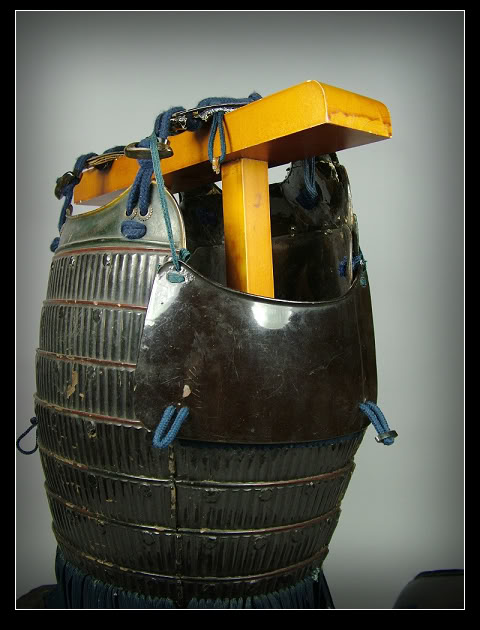
Wakibiki: Armpit protectors worn inside the chest armor (dou), made from leather (nerigawa) hexagon plates (kikko). The kikko are connected to each other by chain armor (kusari).
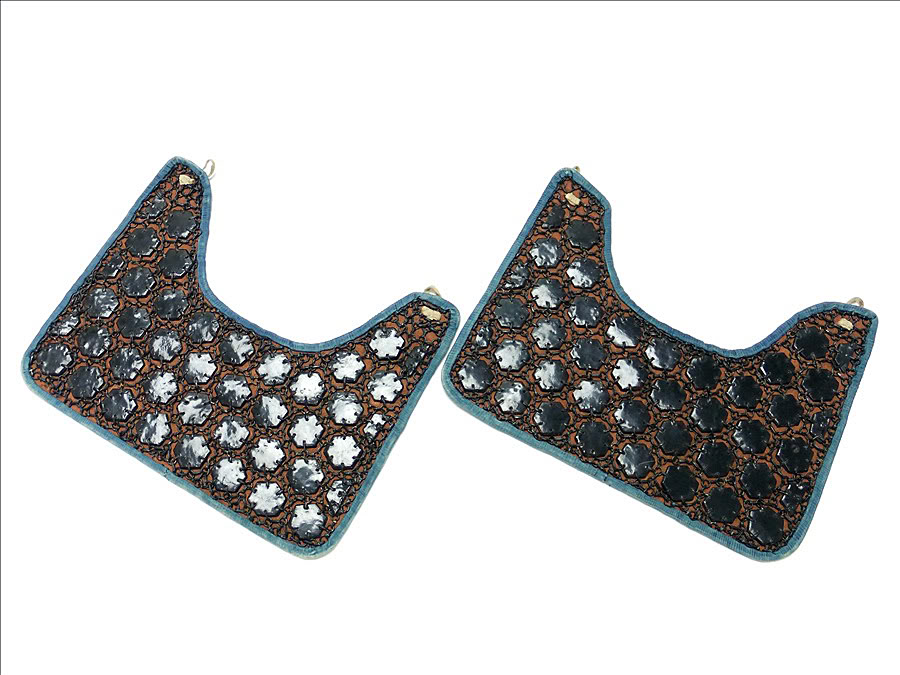
Manju no wa: A wrap around tight vest made with chain armor (kusari) and leather (nerigawa) hexagon armor plates (kikko), the kikko is sewn between the layers of cloth in the vest.
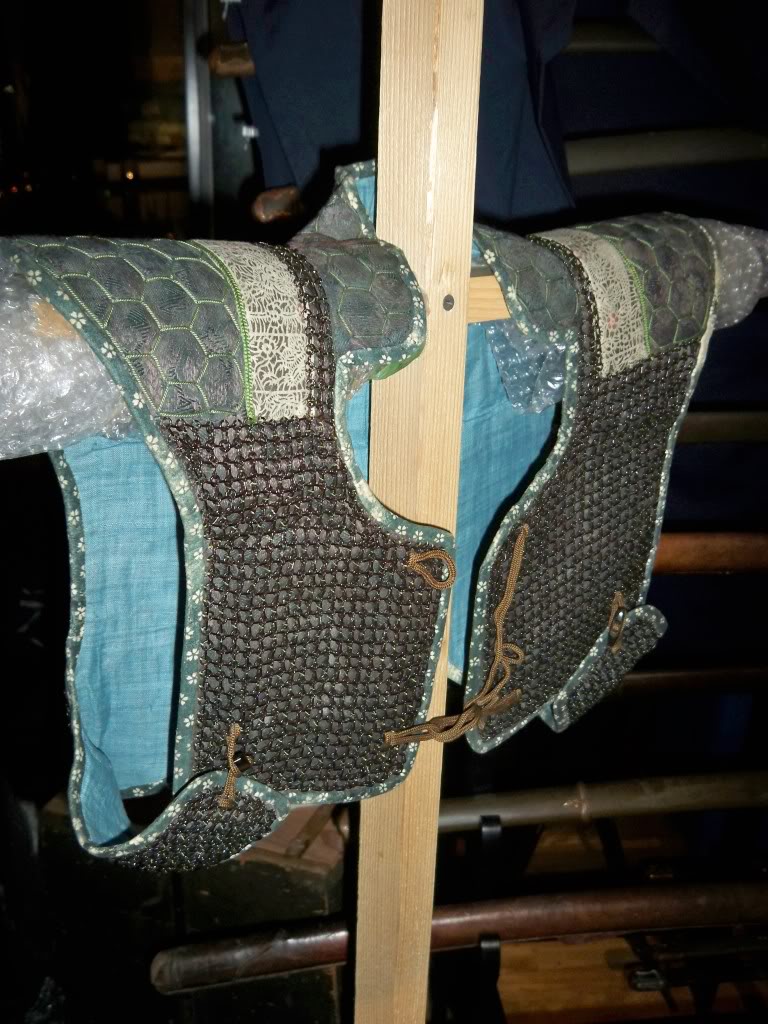
Manchira: A vest made with leather (nerigawa) hexagon armor plates (kikko) sewn between the layers of cloth in a vest.
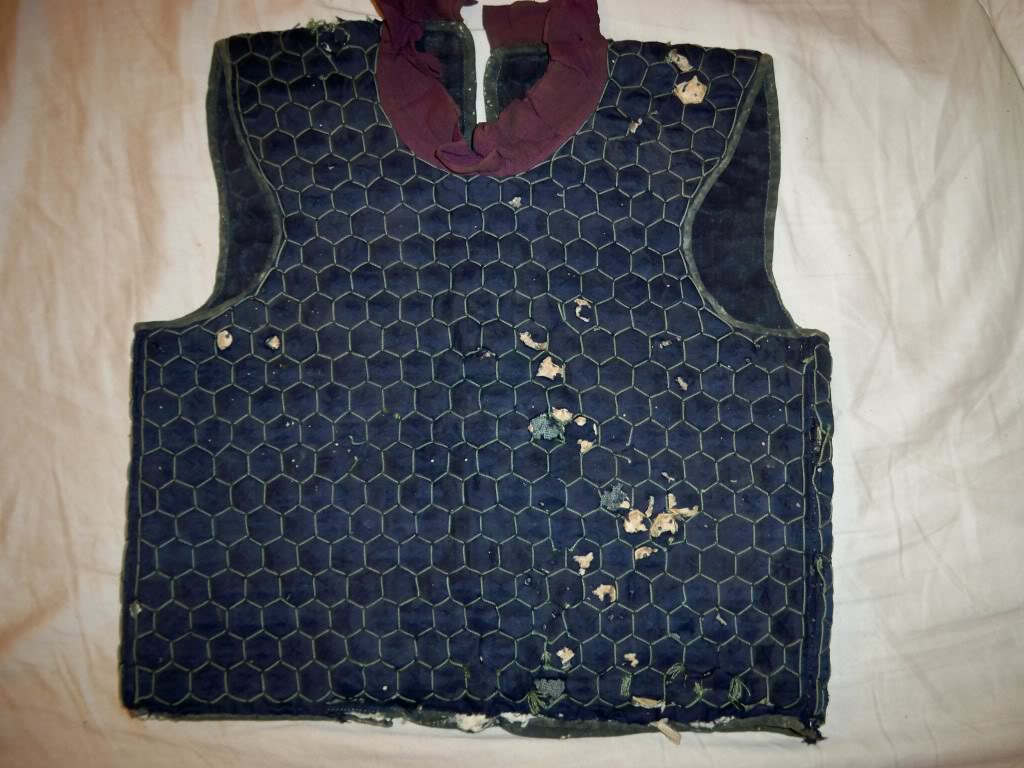
Lower stomach protector, chain armor (kusari) sewn inside a cloth belt.

|
|
   |
 |
William Frisbee

Location: South Shore, MA Joined: 07 Nov 2005
Posts: 93
|
 Posted: Wed 16 Mar, 2011 6:31 am Post subject: Posted: Wed 16 Mar, 2011 6:31 am Post subject: |
 |
|
| Greg Mele wrote: | William,
Well, two things with your data:
1. It is closer to 5'7 than 5'6" - 
2. It is also a mean, averaged across class. This last part is quite significant in pre-industrial society, as the nobility and gentry are often a couple inches taller, do to greater protein in the diet.
As a rule, Medieval man was smaller, but men of 6' or more were hardly freakish giants. What is probably best to say is that the average was a few inches shorter, varying by class and locale. It's probably best to put it this way: there are a fair number of men who are 6'5 today, but they are tall enough to be notable in a crowd - that is much how someone like Richard I or Edward III - both estimated at about 6'2 - 6'3 from skeletal fines, would have looked in a comparable room of contemporaries.
Best,
Greg |
Greg,
thats kinda the point. Its not as if the commoners were wearing armour...
|
|
  |
 |
William Frisbee

Location: South Shore, MA Joined: 07 Nov 2005
Posts: 93
|
 Posted: Wed 16 Mar, 2011 6:38 am Post subject: Posted: Wed 16 Mar, 2011 6:38 am Post subject: |
 |
|
| Eric S wrote: | | Michael Curl wrote: | Ya I know those parts but I was always under the impression that they tended to hang rather low and left an open spot between the do and the kusazuri/haidate that could be thrust through with only cloth in the way. Is that true or is there something else there or is there not enough of a gap.
Edit: also, have you posted your kit on the kits and harness's thread? I would love to see it. |
What is usually missing on the samurai armors on display or for sale are all the auxiliary armors that were available to cover the open areas often pointed out by people as weak areas. There were special armor pieces for the armpit area (wakibiki), for the upper chest and armpit (manju no wa) and armored vests (manchira), there were armored cloth belts which hung over the lower stomach and groin area. These auxiliary armors were made from plain solid iron or leather (nerigawa) plate . Various small armor plates would be sewn to a cloth backing, small iron iron or leather (nerigawa) hexagon plates (kikko), small rectactangular iron or nerigawa plates (karuta). Chain armor (kusari) was also used to make these auxiliary armors, the kusari would be sewn to a cloth backing. Besides offering additional armored protection to certain areas these items could also be heavily padded with cloth covering the armor and layers of cloth under the armor. Here are some pictures of a few different types of auxiliary samurai armor pieces.
Wakibiki: Armpit protectors made from solid plates worn outside the chest armor (dou).
Wakibiki: Armpit protectors worn inside the chest armor (dou), made from leather (nerigawa) hexagon plates (kikko). The kikko are connected to each other by chain armor (kusari).
Manju no wa: A wrap around tight vest made with chain armor (kusari) and leather (nerigawa) hexagon armor plates (kikko), the kikko is sewn between the layers of cloth in the vest.
Manchira: A vest made with leather (nerigawa) hexagon armor plates (kikko) sewn between the layers of cloth in a vest.
Lower stomach protector, chain armor (kusari) sewn inside a cloth belt.
|
Good information.
Wakibiki, manju no wa and manchira were also not always worn, or available.
Mnchira was also frequently worn under clothing as a type of hidden armour.
|
|
  |
 |
|
Sean Manning
|
 Posted: Wed 16 Mar, 2011 7:17 am Post subject: Posted: Wed 16 Mar, 2011 7:17 am Post subject: |
 |
|
|
What level of proof are we talking about here? I'd expect that armour with teppo-proof components would be heavier than some of the later armour which was unlikely to be used in combat. It might be interesting to get the weight of individual pieces, since the materials of Japanese armour were so diverse.
|
|
  |
 |
William Frisbee

Location: South Shore, MA Joined: 07 Nov 2005
Posts: 93
|
 Posted: Wed 16 Mar, 2011 8:59 am Post subject: Posted: Wed 16 Mar, 2011 8:59 am Post subject: |
 |
|
| Sean Manning wrote: | | What level of proof are we talking about here? I'd expect that armour with teppo-proof components would be heavier than some of the later armour which was unlikely to be used in combat. It might be interesting to get the weight of individual pieces, since the materials of Japanese armour were so diverse. |
MOST of the the teppo proof okegawa, hotoke, hatomune, sendai (hard to believe that Sendai is mostly gone now) dou that I've seen were very much equivalent in weight to the globose, peascod and segmented/placard style proofed armour that I've dealt with as well.
Yes, Japanese firearms were behind the level of those used in Europe. But the armour seems to have been rather close in its abilities.
|
|
  |
 |
Eric S

|
 Posted: Wed 16 Mar, 2011 11:59 pm Post subject: Posted: Wed 16 Mar, 2011 11:59 pm Post subject: |
 |
|
Early 1600s Hosokawa clan full suit of armor in the Etchu style. It has an Etchu style zunari kabuto and a real Iyozane dou , Iyozane are true individual large scales, the dou is constructed in 1 piece with no hinge, the wearer just pulls it open to wear it. The entire suit of armor with armor box weighs 39lbs. This type of armor was light weight and maneuverable.
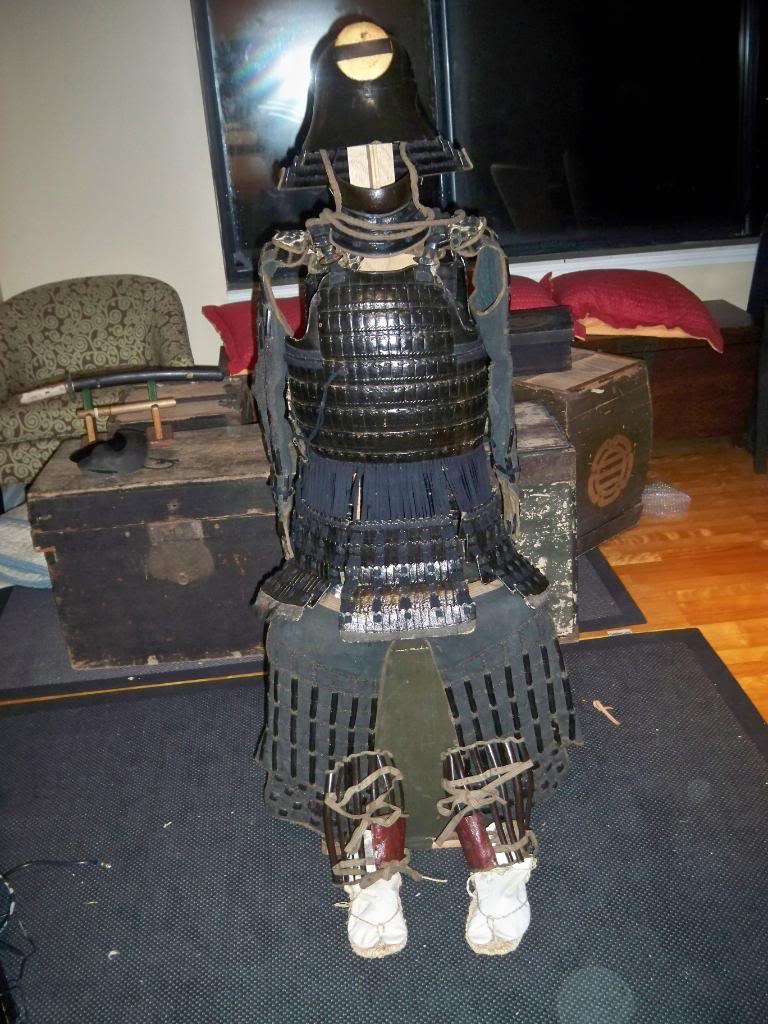
|
|
   |
 |
|
|
You cannot post new topics in this forum
You cannot reply to topics in this forum
You cannot edit your posts in this forum
You cannot delete your posts in this forum
You cannot vote in polls in this forum
You cannot attach files in this forum
You can download files in this forum
|
All contents © Copyright 2003-2025 myArmoury.com — All rights reserved
Discussion forums powered by phpBB © The phpBB Group
Switch to the Basic Low-bandwidth Version of the forum
|

